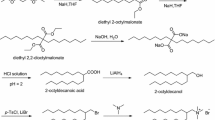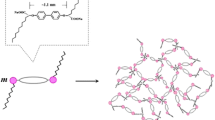Abstract
A novel cationic surfactant Guerbet-cetyl trimethyl ammonium chloride (G-CTAC) was synthesized by combining several traditional synthetic processes in laboratory. The molecular structure of G-CTAC was characterized by Fourier transform infrared (FT-IR) spectra and proton nuclear magnetic resonance (1HNMR). This new amphiphile exhibited excellent performances in aqueous solution, which was investigated by surface tension measurement, contact angle on parafilm, particle size of aggregates, transmission electron microscopy (TEM), emulsifying experiments, and antistatic tests. It was found that the new quaternary ammonium compound could effectively decrease the surface tension of aqueous solution to 26.2 mN m−1 with the critical micelle concentration (CMC) being 5.9 mmol L−1. In addition, the cationic surfactant synthesized could efficiently decrease the contact angle of aqueous solution on paraffin surface. We suppose that these unique properties are attributed to the presence of the branching Guerbet-cetyl being hydrophobic group in the molecule. Moreover, according to TEM observations, this quaternary ammonium compound was inclined to aggregate into vesicles spontaneously without induction of any other additives in aqueous solution. Antistatic tests and emulsifying experiments were also conducted to explore the potential applications of this new material.








Similar content being viewed by others
References
O’Lenick AJ Jr (2001) Guerbet chemistry. Journal of Surfactants and Detergents 4(3):311–315. doi:10.1007/s11743-001-0185-1
Carlini C, Di Girolamo M, Macinai A et al (2003) Selective synthesis of isobutanol by means of the Guerbet reaction: Part 2. Reaction of methanol/ethanol and methanol/ethanol/n-propanol mixtures over copper based/MeONa catalytic systems. Journal of Molecular Catalysis A: Chemical 200(1):137–146. doi:10.1016/S1381-1169(03)00042-6
Carlini C, Marchionna M, Noviello M et al (2005) Guerbet condensation of methanol with n-propanol to isobutyl alcohol over heterogeneous bifunctional catalysts based on Mg–Al mixed oxides partially substituted by different metal components. Journal of Molecular Catalysis A: Chemical 232(1):13–20. doi:10.1016/j.molcata.2004.12.037
Matsu-Ura T, Sakaguchi S, Obora Y et al (2006) Guerbet reaction of primary alcohols leading to β-alkylated dimer alcohols catalyzed by iridium complexes. The Journal of organic chemistry 71(21):8306–8308. doi:10.1021/jo061400t
Kozlowski JT, Davis RJ (2013) Heterogeneous catalysts for the guerbet coupling of alcohols. ACS Catalysis 3(7):1588–1600. doi:10.1021/cs400292f
Kenar JA, Knothe G, Copes AL (2004) Synthesis and characterization of dialkyl carbonates prepared from mid-, long-chain, and guerbet alcohols. Journal of the American Oil Chemists’ Society 81(3):285–291. doi:10.1007/s11746-004-0897-4
Knothe G, Carlson KD (1998) Synthesis, mass spectrometry, and nuclear magnetic resonance characterization of di-Guerbet esters. Journal of the American Oil Chemists’ Society 75(12):1861–1866. doi:10.1007/s11746-998-0342-y
Huang C, Li Q, Li M et al (2014) Synthesis and properties of Guerbet hexadecyl sulfate. Tenside Surfactants Detergents 51(6):506–510. doi:10.3139/113.110335
Varadaraj R, Bock J, Valint P Jr et al (1991) Fundamental interfacial properties of alkyl-branched sulfate and ethoxy sulfate surfactants derived from Guerbet alcohols. 1. Surface and instantaneous interfacial tensions. The Journal of Physical Chemistry 95(4):1671–1676. doi:10.1021/j100157a033
Varadaraj R, Bock J, Valint P Jr et al (1991) Fundamental interfacial properties of alkyl-branched sulfate and ethoxy sulfate surfactants derived from Guerbet alcohols. 2. Dynamic surface tension. The Journal of Physical Chemistry 95(4):1677–1679. doi:10.1021/j100157a034
Varadaraj R, Bock J, Valint P Jr et al (1991) Fundamental interfacial properties of alkyl-branched sulfate and ethoxy sulfate surfactants derived from Guerbet alcohols. 3. Dynamic contact angle and adhesion tension. The Journal of Physical Chemistry 95(4):1679–1681. doi:10.1021/j100157a035
Qiao W, Cui Y, Zhu Y et al (2012) Synthesis and surface activity of Guerbet betaine surfactants with ethylene oxide groups. Tenside Surfactants Detergents 49(3):252–255. doi:10.3139/113.110190
Katarzyna D, Krystyna P (2008) The effect of molecular structure on the surface properties of selected quaternary ammonium salts. Journal of colloid and interface science 321(1):220–226. doi:10.1016/j.jcis.2008.01.049
Kimura H (2011) Progress in one-step amination of long-chain fatty alcohols with dimethylamine-development of key technologies for industrial applications, innovations, and future outlook. Catalysis Reviews: Science and Engineering 53(1):1–90. doi:10.1080/01614940.2011.556913
Dong S, Li Y, Li Q (2013) Study on one-step catalytic amination of oleyl alcohol to unsaturated tertiary amine. Research on Chemical Intermediates 39(3):869–874. doi:10.1007/s11164-012-0600-3
Li Y, Li Q, Zhi L et al (2011) Catalytic amination of octanol for synthesis of trioctylamine and catalyst characterization. Catalysis letters 141(11):1635–1642. doi:10.1007/s10562-011-0686-z
Lee CH, Yang YM, Chang CH (2014) Enhancing physical stability of positively charged catanionic vesicles in the presence of calciumchloride via cholesterol-induced fluidic bilayer characteristic. Colloid Polym Sci 292:2519–2527. doi:10.1007/s00396-014-3285-x
Lee C H, Yang Y M, Leu K M, et al. (2015) Exploring physical stability characteristics of positively charged catanionic vesicle/DNA complexes. Colloid Polym Sci. DOI: 10.1007/s00396-015-3608-6.
Rosen M J, Kunjappu J T (2012) characteristic features of surfactants. In: Surfactants and interfacial phenomena, 3rd edn. John Wiley & Sons, pp1-33.
Kunieda H, Shinoda K (1978) Solution behavior of dialkyldimethylammonium chloride in water. Basic properties of antistatic fabric softeners. The Journal of Physical Chemistry 82(15):1710–1714. doi:10.1021/j100504a010
XU Z, ZHOU C, JIN Z et al (2009) Study of synthesis and surface active properties of novel Guerbet surfactants. Fine Chemicals 3:009
Jung HT, Coldren B, Zasadzinski JA et al (2001) The origins of stability of spontaneous vesicles. Proceedings of the National Academy of Sciences 98(4):1353–1357
Alexander S, Smith GN, James C et al (2014) Low-surface energy surfactants with branched hydrocarbon architectures. Langmuir 30:3413
Guo X, Li H, Zhang F, Zheng S, Guo R (2008) Aggregation of single-chained cationic surfactant molecules into vesicles induced by oligonucleotide. Journal of colloid and interface science 324:185–191. doi:10.1016/j.jcis.2008.04.057
Bramer T, Dew N, Edsman K (2007) Pharmaceutical applications for catanionic mixtures. J Pharm Pharmacol 59(10):1319–1334. doi:10.1211/jpp.59.10.0001
Rosa M, Miguel M, Lindman B (2007) DNA encapsulation by biocompatible catanionic vesicles. J Colloid Interface Sci 312:87–97. doi:10.1016/j.jcis.2006.07.084
Wu C-J, Kuo A-T, Lee C-H, Yang Y-M, Chang C-H (2013) Fabrication of positively charged catanionic vesicles from ion pair amphiphile with double-chained cationic surfactant. Colloid Polym Sci 292:589–597. doi:10.1007/s00396-013-3104-9
Lundberg D, Berezhnoy NV, Lu C, Korolev N, Su C-J, Alfredsson V, Miguel MG, Lindman B, Nordenskiold L (2010) Interactions between cationic lipid bilayers and model chromatin. Langmuir 26:12488–12492. doi:10.1021/la1014658
Sommer HZ, Lipp HI, Jackson LL (1971) Alkylation of amines. General exhaustive alkylation method for the synthesis of quaternary ammonium compounds. The Journal of Organic Chemistry 36(6):824–828. doi:10.1021/jo00805a021
Li M, Li Q X, Hou S Z, Zhang M H and Li Y L: CN103272608A
Mata J, Varade D, Bahadur P (2005) Aggregation behavior of quaternary salt based cationic surfactants. Thermochimica Acta 428(1):147–155. doi:10.1016/j.tca.2004.11.009
Lee EM, Thomas RK, Penfold J et al (1989) Structure of aqueous decyltrimethylammonium bromide solutions at the air water interface studied by the specular reflection of neutrons. The Journal of Physical Chemistry 93(1):381–388. doi:10.1021/j100338a073
Rosen M J, Kunjappu J T (2012) Adsorption of surface-active agents at interfaces-the electrical double layer. In: Surfactants and interfacial phenomena, 3rd edn. John Wiley & Sons, pp35-103
Dahanayake M, Cohen AW, Rosen MJ (1986) Relationship of structure to properties of surfactants. 13. Surface and thermodynamic properties of some oxyethylenated sulfates and sulfonates. The Journal of Physical Chemistry 90(11):2413–2418. doi:10.1021/j100402a032
Dutschk V, Sabbatovskiy KG, Stolz M et al (2003) Unusual wetting dynamics of aqueous surfactant solutions on polymer surfaces. Journal of colloid and interface science 267(2):456–462. doi:10.1016/S0021-9797(03)00723-9
Nagarajan R (2002) Molecular packing parameter and surfactant self-assembly: the neglected role of the surfactant tail. Langmuir 18(1):31–38. doi:10.1021/la010831y
Wilk KA, Poźniak R, Sokoŀowski A (2000) Antistatic and wetting properties of chemodegradable cationic surfactants containing 1, 3-dioxolane moiety. Journal of Surfactants and Detergents 3(2):207–211. doi:10.1007/s11743-000-0127-y
Acknowledgments
We gratefully acknowledge financial support from the National Science and Technology Support Project of China (No. 2014BAE03B03) and Shanxi Province Science Foundation for Youths (No. 2013021009–4).
Author information
Authors and Affiliations
Corresponding author
Rights and permissions
About this article
Cite this article
Zhang, Y., Li, Y., Song, Y. et al. Synthesis and aggregation behaviors of tail-branched surfactant Guerbet-cetyl trimethyl ammonium chloride. Colloid Polym Sci 294, 271–279 (2016). https://doi.org/10.1007/s00396-015-3771-9
Received:
Revised:
Accepted:
Published:
Issue Date:
DOI: https://doi.org/10.1007/s00396-015-3771-9




